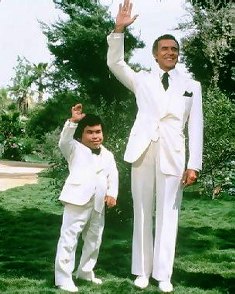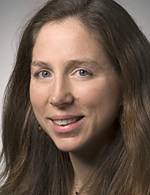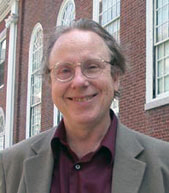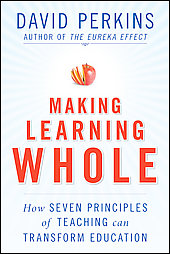Dewey 21C: May 2009 Archives
 Perhaps you're thinking that espresso isn't exactly one of the arts education disciplines traditionally found in state standards.
Perhaps you're thinking that espresso isn't exactly one of the arts education disciplines traditionally found in state standards.Yes, that may be so. Nevertheless, if you don't know espresso as an art form, perhaps it's time to join the third wave. The Third Wave of Coffee that is.
I think the best place to start with espresso art is with a look. Here's one for you:
 Here's another, a bit more traditional:
Here's another, a bit more traditional: And what the hell, one more:
And what the hell, one more: This is what is known as latte art. And yes, I can do some of it, but not all of it, because I use skim milk which doesn't expand when frothed the way whole milk does (it's all in the fat content).
This is what is known as latte art. And yes, I can do some of it, but not all of it, because I use skim milk which doesn't expand when frothed the way whole milk does (it's all in the fat content).The art is not limited to latte making. It's in how the espresso is ground, placed in the portafilter (the small metal filter in the espresso handle that holds the ground espresso), how the espresso is pressed (tamped) down in the filter with the tamper, and exactly how long you allow the water to pass through the compressed espresso (what is referred to as a pull).

All of these things interact as part of one espresso ecology, including the type of bean or beans used in the roast, the duration of the roast, the kind of roaster used, how old the beans are, how hot the water is, how much pressure the water is under, and even the temperature/humidity in the room.
Some of you may wonder why anyone would ever undertake such an endeavor. And of course, this doesn't include what goes into the frothing, if you choose to make a latte/cappuccino, etc. That's a whole 'nother interactive bit of art, including type of milk, angle of the frother, depth of the frother...you catch my milky drift?
Go to one of the great Third Wave espresso joints and order an espresso. Many of these places pull what is called a Triple Ristretto, which is a very short pull (less water), with a third more beans packed into the portafilter, which in the hands of a master barista will produce a shot that is mostly crema (that cream on the top of the espresso) and relatively little liquid. It will have a wildly different taste then you have ever tasted before. Forget that little bit of lemon peel you've had on the side.
Here's a pic:
 How about that!!!! See all the colors, the reds and browns--
How about that!!!! See all the colors, the reds and browns-- believe me, this is all crema, all the time. If you order an espresso and it's beige, and there's only a little bit of crema at the top, which is how it served at about 99% of the places across the country even today, well, it's going to be sour, thin, and well, a waste of calories, not to mention a waste of time and money. I guess the caffeine delivery will remain intact, which is vital, I give you that.
believe me, this is all crema, all the time. If you order an espresso and it's beige, and there's only a little bit of crema at the top, which is how it served at about 99% of the places across the country even today, well, it's going to be sour, thin, and well, a waste of calories, not to mention a waste of time and money. I guess the caffeine delivery will remain intact, which is vital, I give you that.For many years, espresso in America was limited to a few Italian restaurants, just the small minority that had some connection to Italy, I guess, and wanted to offer a homeland drink on the menu. That being said, the stuff was horrendous, as is much of the espresso I encounter today, even with the Third Wave. Go to Starbucks and order an espresso, if you want to see what I mean. Yikes. The little lemon peel they used to serve with the espresso was to counteract the terrible bitterness of the vile liquid.
In 1992 I went to Italy for the first time, and got hooked on espresso. (I also declared myself at the time, an "Honorary Italian.") I didn't get hooked at the fancy cafes, but rather at the highway-side restaurants off the autostrada called Autogrill. You could get great pannini, sit down for a very good bowl of pasta, and sidle up to the bar for these fantastic espressi that the baristi were cranking out one after the other. The Italians would add sugar, and just down the espresso in practically one gulp, leave a small tip on the counter, and then bolt for their la macchina to continue along on merry caffeinated way...
I was hooked.
And in case you missed it: we have McDonald's; they have Autogrill. Who wouldn't declare themselves an honorary Italian?
The day after returning to New York, I bought my first espresso machine: A DeLonghi. Then I went to a Baby Gaggia. Then I went to Liva 90. Today, I own a Vetrano by Quickmill.
This:

begat this:

which begat this:
 Now this:
Now this: The Vetrano is plumbed in directly to my cold water line, so I never have to manually add water. (The espresso machines where you have to add water by hand, is called a "pour over" machine.) The water line is double filtered, for sediment and for minerals. I did it all myself, including tapping into the cold water line, installing the filters, and drilling through the floorboards and counter top.
The Vetrano is plumbed in directly to my cold water line, so I never have to manually add water. (The espresso machines where you have to add water by hand, is called a "pour over" machine.) The water line is double filtered, for sediment and for minerals. I did it all myself, including tapping into the cold water line, installing the filters, and drilling through the floorboards and counter top.And of course, you've got to have a great grinder:
 The approach to espresso is regionally based. In Italy, if you go North, the espresso is smooth; the beans are chocolate in color, not black. Very far north, in say a place like Trento, they will give you espresso, and a small beaker of cold milk, as well as a small beaker of warm milk, for you to create your own macchiato. It's very elegant and civilized.
The approach to espresso is regionally based. In Italy, if you go North, the espresso is smooth; the beans are chocolate in color, not black. Very far north, in say a place like Trento, they will give you espresso, and a small beaker of cold milk, as well as a small beaker of warm milk, for you to create your own macchiato. It's very elegant and civilized.Try the espresso down south in Naples. There's a splendid place right across from the Teatro San Carlo (the opera house): Gran Caffe Gambrinus. They've got these wild espresso machines with super long handles that control the pull. It's looks very much like the wonderful cafes in Vienna, where Lenin and Freud hung out (Cafe Central).
The place in Naples serves a very short pull that is almost burned and sort of spicy. It's a southern Italian approach. A northerner would probably spit it out.
There are two places in Rome that I absolutely love, and they are both right near the Pantheon. Cafe Tazzo d'Oro and Cafe Sant'Eustachio.
Tazza D'Oro has a Jamaica Blue Mountain roast espresso, that is a one of a kind. They have these ancient roasters right there in the cafe. D'Oro keeps their cups warmed to the perfect temperature prior to the pull by keeping them in a water bath.
Go Northwest in the US, and the beans are black. That's the kind of espresso you get in the Fotomats converted to drive-through espresso joints. Ever see one of them? (Oddly enough, in this over-caffeinated region of the US, they have bikini-clad espresso servers) The Northwest style espresso is, I am sorry to say, not my cup of coffee.

In the last few years things have really taken off in New York City and beyond: there are amazing roasters and espresso places all over the country. Take a look at Intelligentsia, which is where I get my beans delivered from right to my home, every two weeks come rain or shine; Stumptown; Counter Culture Coffee; Novo, Metropolis (my current fav), and many others.
If you want to roast your own, here's a great website for that: Sweet Maria's.
So, where do I go in NYC when I want a great triple ristretto? Cafe Grumpy; Stumptown, and Ninth Street Espresso. Fortunately, my work takes me to the Tweed Courthouse and the offices of the City Council and State Legislature in downtown Manhattan. There is a great joint on Chambers Street, that only serves a double ristretto: Blue Spoon, but they use Intelligentsia's Black Cat Espresso. Intelligentsia, based in Chicago, doesn't do the triple pull either. Nevertheless, one of their baristi was the reining champ of the World Barista Competition.
My pal Harold Meltzer swears by Abraço in the East Village, but what does he know? Actually, Harold is right, the place, about the size of a walk-in closet, might just be the best in the city.
 For those who like Kaffee mit Schlag and a nice Viennese pastry, New York City now has
For those who like Kaffee mit Schlag and a nice Viennese pastry, New York City now hasan official outpost of one of the great Viennese Cafes: Demel. It's a very different kind of coffee, but just splendid, particularly with the fresh creme (schlag), the kind your cardiologist lectures against. If you make it there, try the topfen strudel, which is a sweet cheese strudel. I once spent a week in Vienna, for an international music conference, and everyday at 4pm, I would go to one of the great cafes, have my Kaffee, and one of those topfen strudel. Ah, those were the days! Okay, it's another thing your cardiologist won't like, true. And if you don't have a cardiologist, keep going to Demel, for it's a sure route for getting one, schnell.
Go into any of these Third Wave places, and you will see something new: the barista will pull the shot, smell it, taste it, and then very likely toss it in the trash. Then she or he will make the adjustment for all the things I mentioned earlier, and try again. Sometimes it will be the third or fourth pull that you will be served. It could be sour, thin, bitter; they're looking for just the right taste and smell, and they make adjustments even as the pull is happening, based on the color and density of the espresso coming out of the machine. When it's right, they serve it. Otherwise into the knock box and down the drain it goes.
So, there you have it. An Espresso Arts Education. While some of you may be thinking "get a life," in my own defense, I do want to point out that the thoughtfulness, the care, the science, the art, the history, and all of the other little things that go into this little world of espresso are indeed an art form, perhaps more of the art of living or the everyday art of life.
When people think that arts education is elite, I point to the art of espresso, or the art of gardening, or the art of entertaining, or the art of writing a personal letter or note, or the art of how your greet someone--the ways in which the an artful existence is all around us and within us, which makes us better, and certainly, well, more artful.












 These types of reports are coming down the pike daily, from all different parts of the country. This one has a bit more to it as there is an interesting blog post and follow-up posts on the Dallas Morning News website.
These types of reports are coming down the pike daily, from all different parts of the country. This one has a bit more to it as there is an interesting blog post and follow-up posts on the Dallas Morning News website.Ignore the title, as it won't do you much good, but take a look at what's coming up on the forum:
A Possible Exclusion for Learning Centers
Here's a bit of flavor from the piece:
Will keep you posted...Posted by expressyourself @ 11:45 PM Wed, May 27, 2009The numbers at Sidney Lanier Expressive Arts Vanguard still not looking so good.
This is the only elementary in Dallas to offer students two Expressive Arts classes every day from Theater,Dance,Visual Art,Band,Orchestra, Piano and Choir. The staffing information shows only 6 Vanguard teachers.This number is based upon a no rehire for the vacant Vanguard Choir teacher position at midyear. The current formula appears to leave Lanier with 3.5 out of 7 Vanguard positions. That alters the program beyond recognition.These positions represent 7 different disciplines taught by teachers with very specific areas of training.The parents and students who interviewed for Lanier did so because of the Vanguard program. How many of them will stay if the program doesn't exist? Lanier's Exemplary rating is due to the successful partnership between the Arts teachers and the classroom teachers.The destruction of the Vanguard program hurts the entire school and every student...not just the Vanguard program. This is a comprehensive neighborhood school which should have an Art teacher and a Music teacher to serve the home school students. Currently there is no music teacher;the Vanguard teachers work together to offer music to these students. Looking at some of the cuts at other schools there seems to be a pattern of cutting Arts education. Wonder what the Wallace Foundation thinks about that? Or Big Thought? Or DISD's very own Fine Arts administrators? Lanier is a scrappy little school with no one really speaking out for it. Mr Jerome Garza is the trustee representing Lanier's interests. No doubt he recognizes what is at stake here. Parents did try to communicate their opinions to Dr. Hinojosa. He did not appear to appreciate their attempt to exercise their right to free speech or to assemble. Their effort to support their school was dismissed. And we wonder why we can't get more parental involvement. Please, all parents stay strong and work together. You make the biggest difference.

An obituary appeared in the New York Times yesterday for Dr. Thomas Minter. Minter was part of a great battle of a sorts around the ability of then Mayor Ed Koch to dictate the hiring of the schools chancellor. It was a battle that in many ways foretold what was to come twenty years later.
In essence, you had Minter, then deputy chancellor with an doctorate in education from Harvard, emerge as a leading candidate for the chancellor of schools in 1983, backed by supporters including the Roman Catholic Archdiocese, a broad range of political support, and more.
Back then, the school board was not controlled by the Mayor. Nevertheless, Mayor Koch wanted his deputy mayor and close friend Robert Wagner, Jr., to become chancellor and found a way to sway the school board into backing Wagner.
In the end, the State Department of Education refused to waive Wagner's required education credentials, Minter fell by the wayside, and Anthony Alvarado was appointed chancellor. A few years later Wagner ended up running the NYC school board--The Board of Education, performing ably in that position.
I guess what's most interesting in all of this is that control of school boards can be had by a mayor whether or not it is dictated by the laws governing schools. You could also say that Ed Koch was way ahead of his time in wanting to appoint a non-educator as the school district leader. I would imagine that this was practically unheard of back then. Of course, today, it's quite fashionable to go the non-educator route for a school superintendent.
In 1983, the New York State Education Department exercised its authority, stepped in and refused to approve such a position without bona fides in education. That speaks volumes too.
What about Minter? A stellar career in education, including having a resume featuring first assistant secretary for elementary and secondary education at the USDOE, superintendent of schools in Wilmington, Delaware, extensive teaching experience, and even a deputy chancellor position in New York City public schools, found that politics trumped achievement.
Finally, it must be noted that Minter was African American, and had an early career in music, with a Master's Degree in Sacred Music.
I have met a lot of school superintendents, but have never, I am sorry to say, ever met one who had a credentialed background in the arts.
You see, when we first started protesting about the elimination of dedicated funding for arts education, we were told: "don't worry, there is so much more money coming to the schools every year, Project Arts (the dedicated funding) no longer matters."
So, in essence, it was that we shouldn't 't bother to fight for dedicated funding, as there is so much money going to the schools, that the point is moot.
Now, it's the opposite: "how can you ask for dedicated funding for the arts when budgets are being cut? There is no money."
So, you have a choice: do nothing, ever, or advocate always.
 Yesterday, the New York City schools chancellor addressed next year's school budget. Today, principals will receive their budgets for next year.
Yesterday, the New York City schools chancellor addressed next year's school budget. Today, principals will receive their budgets for next year.
"James Harrigan at Public School 229 in Brooklyn said he expected his cut to be about $170,000."
"My after-school programs will probably take a hit; a lot of those are arts programs," he said. "That's one reason kids like to come to school."
"If they have a Saturday program, they may have to cut something like that. It may affect their after school program, some school may affect the costs that they spend on professional development."
As many of you know, there has been tremendous growth in arts being provided as part of after-school, or out-of-school time programs. I have been under tremendous pressure to move my organization's interest into after school, as the people doing the pressure argued that there simply wasn't time in the school day anymore. And, I have thought about it, quite a bit. While we have some programs that are after school, particularly those involving students and parents, we have continued to focus on the traditional school day, until and unless the school day in New York City public schools becomes extended on an official basis. The reasons for not giving in to the pressure to focus on after school, leads back to what one of my mentors has been rather forceful about: "when budget cuts are made, after school has always been among the first to go."

It is a campaign to restore dedicated funding for arts education in the New York City public schools. When Jane wrote about Project Arts yesterday, that is the dedicated funding we are seeking to restore.
It is not only a campaign in and of itself, with a theory of change and logic model we've developed, centered in a first phase that seeks to pass a resolution (#837) in the New York City Council, but it is also a vehicle for organizing and building a broad-based constituency necessary to advocate for arts education long-term.
Here's the campaign sign-on letter, take a look at the partners, and note that we've got thousands of people signed on, including over 1,000 parents as part of a parent-led coalition that has formed around the campaign, a wide variety of organizations, celebrities, and over 30 City Council member co-sponsors to the resolution, and the community is growing daily. The letter is followed by the actual Resolution, and a list of the current City Council co-sponsors. Oh, and you will have to forgive the various fonts anomalies, for clipping all of this into the blog was tricky and I just could not get the fonts to all appear correctly.
Sign-On Letter

Dear Colleagues:
We are joining
together to call on the City to take an important step to restore quality arts
education in
The NYC Department of Education's assessments show that the City's
public schools are not meeting state requirements for arts education. Hundreds of thousands of
Ensuring that every child receives a quality
arts education is important to us because:
o
We agree with Mayor Bloomberg that, "arts
instruction is essential to a high-quality education."
o
Learning in the arts connects to a wide array of
social and academic benefits
o
Education means developing a creative, critically
thinking mind that can meet the challenges of the 21st Century
o
A well-rounded education leads to better job
opportunities and enhances the ability to compete in a new, global marketplace
o
Arts are a critical part of
National studies show that the arts not only
motivate kids to learn more; they also keep youth in school and graduating on
time. Unfortunately, data provided by the NYC Department of Education shows
that schools with the most low-income students offer the least arts
education. Currently, new, stricter
graduation requirements are being implemented, and it is imperative that all
students receive at least the arts education they are entitled to by law supporting
their chances of graduation. Without
the security of dedicated funding for arts education, the opportunity gap will
only continue to widen.
We must have a structure in place to
guarantee that all children can meet minimum standards for arts in the
schools. To that end, we are urging the
City Council and the Mayor to designate a minimum amount of a principal's
budget to be spent directly on arts education - an essential step in ensuring every child receive a quality education
that includes the arts.
Please join us in signing the attached
letter to Mayor Bloomberg and members of the City Council. You may return the letter with a signature or
send an email to Kira Streets, Director of Public Engagement at the Center for
Arts Education, who is coordinating our efforts, or feel free to contact any of
the undersigned to discuss these issues further.
Kira's contact information is below:
Kira
Streets
Director
of Public Engagement
The Center for Arts Education
kira@caenyc.org
Phone: 212-971-3300x324
Fax: 212-268-5266
We believe that cultural, education, labor
and community organizations have an obligation to work together to ensure that
every child in
Sincerely,
Richard Kessler, Executive Director, The
Center for Arts Education
Michael Mulgrew, Chief Operating Officer,
United Federation of
Teachers
Billy Easton, Executive Director, The
Don Fann, Executive Director, Learning
Disabilities Association of
Kim Sweet, Executive Director, Advocates for
Children
Associated Musicians of Greater

Resolution #837
Res. No. 837
Resolution
calling upon the New York City Department of Education to maintain a minimum
level of arts funding in
By Council Members
Whereas, As a result of the fiscal crisis of the 1970s, the New York City public school system experienced a significant reduction in funding for arts education; and
Whereas, In 1997, former Mayor Rudolph Guiliani created Project ARTS (Arts Restoration to the Schools), which was designed to restore arts education to City schools over a three year period; and
Whereas, Project ARTS funding was intended to support direct instructional services, professional development for educators, curriculum development, equipment, art materials and supplies, as well as arts and cultural services; and
Whereas, Project ARTS was initially allocated $25 million a year, has reached upwards of $75 million a year, and in recent years, has received yearly allocations totaling $67.5 million; and
Whereas, According to The Center for Arts Education, Project ARTS has been the "catalyst for the growth and expansion of arts education over the past ten years"; and
Whereas, The importance of arts education and its positive impact on a student's education has been widely researched; and
Whereas, A report by the Arts Education Partnership (AEP) shows a correlation between instruction in the arts and greater student achievement and social development; and
Whereas, In January 2007, Mayor Michael Bloomberg outlined his most recent Children First School Reforms in his State of the City address; and
Whereas, These reforms include four initiatives, one of which is the Public School Empowerment Initiative, which gives principals greater discretion in running their schools, including hiring personnel and managing the budget; and
Whereas, Some arts advocates have expressed concern regarding the continuation of arts programming in public schools since the Department of Education (DOE) has indicated that funds previously earmarked for Project ARTS would now be made available for principals to spend at their discretion; and
Whereas, Arts advocates fear that principals may be inclined to spend funds on more academic programs, rather than arts programs, in order to raise test scores to meet accountability standards that were put forth in the most recent reform; and
Whereas, For example, in 2001 when former Chancellor Harold Levy allowed for the redirection of Project ARTS funds to cover expenses unrelated to arts education, arts education spending was reduced by fifty percent; and
Whereas, Recognizing the importance of arts education, it is imperative that the DOE take action to ensure that arts education programs continue to be made available to all students; now, therefore be it
Resolved, That the Council of the City of New York calls upon the New York City Department of Education to maintain a minimum level of arts funding in New York City public schools.
*Avella, Tony
*Brewer, Gale A.
*Comrie, Jr., Leroy G.
*Dickens, Inez
*Felder, Simcha
*Fidler, Lewis A.
*Foster, Helen D.
*Garodnick, Daniel
*Gentile, Vincent J.
*Gerson, Alan J.
*Jackson, Robert
*James, Letitia
*Katz, Melinda R.
*Koppell, G. Oliver
*Lappin, Jessica
*Liu, John C.
*Mark-Viverito, Melissa
*Martinez, Miguel
*Mendez, Rosie
*Mitchell, Kenneth C.
*Nelson, Michael C.
*Oddo, James S.
*Palma, Annabel
*Recchia, Jr., Domenic M.
*Reyna, Diana
*Sears, Helen
*Stewart, Kendall
*Vallone, Jr., Peter F.
*Weprin, David I.
*Yassky, David

We have known for a long time that
the second or third class status of the arts as general education in our public
schools would probably never change until some powerful people at the national,
state and local level are inspired to declare them essential as a matter of
policy. Ultimately, that policy must be
expressed and rigorously enforced through legislation that asserts the arts must
stand as equal domains with science, math, social studies, English and other
languages. Then, barring a national
shutdown or other Acts of God, when school is open and teaching and learning
are under way in our land, the arts will be taught as carefully and
intentionally as their sister subjects. Why? They contribute to every child's cognitive,
social, civic, physical and emotional development. Just like all the other
subjects. Period.
What prompts this statement, now, in
the middle of yet another financial crisis and threatening foreign wars, is the
Webcast NYC Schools Chancellor Joel Klein delivered a several days ago to the
city's principals warning them of more severe, across the board budget cuts.
(Note: Richard Kessler has posted the full document on the Dewey21C website of
ArtsJournal. It is worth reading.)
I have combined two excerpts that,
without mentioning the arts, makes it crystal clear how the arts, arts
partnerships, and arts afterschool programs are likely to suffer in the year(s)
to come:
"...as you can imagine, the magnitude of the necessary cuts across our school system will mean that most schools will need to significantly reduce OTPS [Other Than Personnel Services], per diem, and per session spending. This means potentially large cuts to after school and supplemental programs...Although you will have the discretion to make the cuts you feel are in the best interest of your schools, you should look carefully at non-personnel areas such as per session and OTPS (italics mine). My staff will be reviewing your preliminary decisions regarding your budgets so that we can get a sense of what the overall impacts are on the system. While you will have the discretion to make the decisions you think best fit your schools, if these decisions seem to tilt too heavily toward excessing, I will ask that you rethink your budget priorities..."
The implicit and
explicit message here is that when principals make decisions for their schools,
the arts ("after school and supplemental programs, per session and OTPS
expenditures") are fair game. This from a chancellor who provided strong
support for the New York City Blueprints for the Arts and the staffing of the
Arts and Special Projects Office at the Department of Education. It is important to remember that
Project Arts money (dedicated funding for the arts that had been roughly $65 per student) has been absorbed into the general budget for each school so
there is no longer even a semblance of a "line item" for the arts as education
in the district.
If the arts were part of the basics in NYC
school policy, Chancellor Klein could have listed arts teachers as immune from
"excessing" and critical community arts services as exceptions, just as he did
with Special Education and Science (among others).
If the policy were in place, and if quality
school partnerships with the community cultural organizations were regularly
assessed and recognized as contributing to the general education of every
child, these partnerships would be eligible for support by both tax money and
private funds, not abandoned or certainly diminished, as is likely to happen
until the fiscal mess we're in clears up.
Whether in small groups, large assemblies or
official meetings, we must begin to nudge a serious agenda forward to address the
towering importance of a coherent, fiscally and geographically equitable arts
policy for the New York City schools. If we do not start to mobilize our
thoughts and take action soon, I worry that teaching and learning in and
through the arts will be seriously jeopardized next year and possibly for many
years to come.
I am not talking about advocacy, here; I am
talking about action protected by wide discussion and hopefully some useful agreement
on the value of the arts to our kids and our society. We cannot afford to wait
for Godot any longer.
Are we up for this challenge?
*******************************************************************
JANE REMER'S CLIFF NOTES
We are at another rocky
precipice in our history that threatens the survival of the arts in our social fabric
and our school systems. The timing and magnitude of the challenges have
prompted me to speak out about some of the most persistent issues in the arts
education field during the last forty-plus years.
My credo is simple: The
arts are a moral imperative. They are fundamental to the cognitive, affective,
physical, and intellectual development of all our children and youth. They
belong on a par with the 3 R's, science, and social studies in all of our
elementary and secondary schools. These schools will grow to treasure good
quality instruction that develops curious, informed, resilient young citizens
to participate fully in a democratic society that is in constant flux.
I have chosen the title Cliff Notes for this forum. It serves as metaphor and double entendre: first, as short takes on long-standing and complicated issues, and second, as a verbal image of the perpetually perilous state of the arts as an essential part of general public education. I plan to focus on possible solutions and hope to stimulate thoughtful dialogue on-line or locally.
*******************************************************************
 Jane Remer has worked nationally for over
forty years as an author, educator, researcher, foundation director and
consultant. She was an Associate Director of the John D. Rockefeller 3rd Fund's
Arts in Education Program and has taught at Teachers College,
Jane Remer has worked nationally for over
forty years as an author, educator, researcher, foundation director and
consultant. She was an Associate Director of the John D. Rockefeller 3rd Fund's
Arts in Education Program and has taught at Teachers College, 
 One day later, if you haven't already heard about Rocco Landesman being nominated as the next chair of the Arts Endowment, you must be on life support, in the witness protection program, or not interested.
One day later, if you haven't already heard about Rocco Landesman being nominated as the next chair of the Arts Endowment, you must be on life support, in the witness protection program, or not interested.You're going to read a lot about Landesman: there will be the profiles, conjecture as to the direction he will take, and of course, all sorts of exhortations on the directions he should take.
Forgetting about Landesman for the moment, I want to take the opportunity to recognize Sarah Cunningham. Do you know her? Well, certainly, if you're in the arts education field, you do, or you should. She is the director of arts education at the Arts Endowment. (One of the reasons I like to use the arts endowment rather than the acronym NEA, is that it sometimes confuses people in education, who know the National Education Association (NEA) better than the National Endowment for the Arts (NEA)).
When Sarah was first appointed, I looked over her resume and thought that she was quite the outlier choice, and also wondered what exactly Dana Gioia was thinking. The first thing I noticed is that she was coming to the position after having immediately worked as director of the Education Assessment and Charter Accreditation Program at the American Academy for Liberal Education in Washington, DC where she supervised a program to assess and accredit liberal arts-oriented charter schools. She had also been dean at a visual arts high school in California and primarily had a background in philosophy. She also was part of the fairly right leaning crowd at places like the Fordham Institute/Foundation.
It was, a brilliant choice made by Dana Gioia.
For those who have been around the block, you've witnessed any number of changes in the way arts education has been situated at the Endowment over the years, that at times appeared to be less than comfortable. For quite a period of time, it was a sub discipline, in fact.
Under Gioia and Cunningham, we have witnessed a growth in place and space for arts education within the Arts Endowment, putting arts education front and center. A matter of emphasis? Yes, certainly. But, it's clearly an act of commission--it was overt and impossible to miss.
Yes, of course, there are some who would like to see the Endowment drop its more programmatic initiatives, like The Big Read, and focus instead on grant making. Those critics believe that programming should be left to the organizations, and funded/fueled by the Endowment. It's a valid argument, whether or not you see it as old school.
What I hope to see, is a continued emphasis on arts education as a leadership issue, from an agency that is by nature looked upon for leadership. I think that one of the best ways to do this is to support Sarah's work, vision, collegiality, and role as a national leader in the field of arts education.
If you've spent any time with Sarah, you quickly realize that she asks questions, is always open to a lively discussion, has a fresh perspective, and connects the dots between arts education and EDUCATION. Her background in philosophy, interest in liberal arts, the direct interest in arts education and a commitment to dialog, to having a real, heady, searching conversation, makes her quite unique and I believe this field is fortunate indeed to have her at the NEA.
So, yes, this is after all about Mr. Landesman, I am in fact exhorting him to support Sarah as an arts education leader, both within the Endowment and across the field. And yes, I have to give a big nod to Wayne Brown too, whom I worked closely with for years when I ran the American Music Center, but don't run into all that much anymore.
Did I mention she's brilliant? Oh, I forgot. She's brilliant.
 A couple of months ago, a grim picture for schools was painted by the Schools Chancellor. Then there was the stimulus package, with a central focus on protecting jobs of teachers. Then there was a budget offered by the Mayor which projected that there would be no teacher layoffs and that the NYCDOE was being protected to a much greater degree than other agencies.
A couple of months ago, a grim picture for schools was painted by the Schools Chancellor. Then there was the stimulus package, with a central focus on protecting jobs of teachers. Then there was a budget offered by the Mayor which projected that there would be no teacher layoffs and that the NYCDOE was being protected to a much greater degree than other agencies. Predicting New York City's income is probably more difficult than ever. Fair enough. That being said, yesterday Joel Klein had a webcast for all of the nearly 1500 principals where a pretty bad picture was painted, which while attempting to hold the line on teacher layoffs, will result in big cuts to non-teaching staffs and programs. Ultimately what to cut will be the decision of each school's principal. On May 18th principals will receive their budgets for next year.
What does this mean for arts education?
Well, since the specifics will vary from school to school, it's hard to tell until the actual budget is revealed. A few weeks ago, I was hearing about cuts of up to six percent, and that's on top of cuts already made, and factoring in stimulus funding.
Basically, what I've written about previously is that the calculus is fairly simple: it's about money in and money out for the arts organizations. We know that corporate and private philanthropy, as well as government funding is down; and cuts to contracted services lines that pay for services of arts organizations willl affect a critical lifeline for each organization working in public schools.
If contracted services, the so-called "soft money" suffers a big hit, that will spell serious trouble for most of the cultural organizations, and yes, of course, in the end the kids will suffer.
As for arts teachers, some will be lost through attrition; some may very well be laid off. And, keep in mind that last year's Arts Count survey by the New York City Department of Education found that from 2006-2007 to 2007-2008, there was a 10% increase in the number of schools without a single arts teacher. That, of course, was before the economic crisis.
Are you wondering, what exactly did the Chancellor write in his memo? Here's a bit of context before you read this memo. There is a no layoff clause in the contract with the United Federation of Teachers. it's important to remember, as while a principal can excess a teacher, they would then go into a fully paid reserve pool called the Alternative Teacher Reserve. These "ATR" teachers serve as substitutes unless the get an assigment at another school, and the school that excessed them is still responsible for a portion of their salary. So, principal empowerment has its limits, as is evident in the memo. Still with me?
Dear Colleagues,
Thank you for joining me on this morning's webcast. I thought it was a productive conversation and I appreciated your questions. We will post the video of the webcast on the Principals' Portal so that those of you who were not able to join us will have the opportunity to watch; in the coming days, we will be following up with more answers to the questions that you asked this morning.
In this note, I will reiterate the key points that I made during this morning's conversation.
I don't have all the answers-but my goal is to give you all the information I have so that you can plan more effectively for the coming school year. I feel strongly that principals are in the best position to make key educational decisions for their schools, and I want to give you the tools you need to exercise the kind of leadership that the City's schools and schoolchildren need in these tough times. This is a hard year-and while the Federal stimulus package is making it more bearable, it does not make us whole from a budget point of view. We still face a substantial budget gap and we're anticipating significant cuts to school budgets. The City and the State are both facing significant declines in revenue as a result of Wall Street and the overall economy.
As you know, this isn't the first year when we've faced budget hardships in our school system. In the last eighteen months, we have already taken three budget cuts. We have consistently made every effort to protect schools and classrooms. During this time, we have eliminated more than 550 positions, or 8%, of the total positions in our central and field offices. We will take more cuts to central and field administration for the upcoming fiscal year, but with our central and field budgets representing only 3% of the total DOE budget, we have no choice but to find savings in our schools and classrooms. Keep in mind that we have many costs-from food and transportation to debt service and pensions-that are the price of running a big school system like ours. We have no control over many of these costs and cannot cut back in these areas.
There are a number of factors that will affect the final numbers for the 2009-10 school year, but it's important that you know how the budget situation will affect your hiring decisions and the budget timeline for the rest of the school year. Here are the three most important facts:
FIRST, as you've heard me say before, principals are in the best position to know what their students and schools need to excel. This year, even though our budget situation is far from ideal, we are maintaining this principle of empowerment. We want to give you the support and flexibility you need to continue focusing on academic achievement.
SECOND, we're expecting that the cut will be an across-the-board percentage reduction to all schools' total budgets. While the percentage will be the same for all schools, schools will take the cuts in different ways, depending on their mix of funding streams and their mix of personnel and non-personnel allocations.
THIRD, we are going to reduce spending without laying off teachers. This is because any layoff of teaching staff is done by seniority, which would require us to force-place teachers until the least senior teachers in the City were laid off. This bumping of staff would violate the principle of empowerment and cause the kind of disruption that we need to avoid. As a result of attrition and your individual decisions to meet budget, the overall number of teachers is likely to go down, but no current teachers will be laid off. This means you will need to look carefully at cutting back other school staff and making reductions in non-personnel areas.OUR BUDGET SITUATION
In January, when I testified before the State Senate Finance Committee and the State Assembly Ways & Means Committee in Albany, I said we faced a $1.4 billion budget gap. Thankfully, our situation today-because of the Federal intervention-is not nearly that bad. The American Recovery and Reinvestment Act will help the Department of Education avoid the situation I outlined in January for the 2009-10 school year. This Federal Stimulus Package money will go a long way-and help us to avoid massive layoffs. However, many of the costs over which we have little or no control have been growing. This leaves us with a substantial funding gap.
Between Fiscal Year 2009 and 2010, the price of education has gone up as teachers' salaries have risen and as the mandated costs for special education services have grown. We also remain committed to some key priorities that the Mayor and I believe will help our schools and our students excel: things like giving you the tools you need to monitor students' performance and progress; closing down failing schools and replacing them with new schools; and creating innovative programs like schoolwide performance bonuses to reward teachers who are successful at helping students make progress. As we face the 2009-10 school year, we all must start thinking about how we can cut back.
SCHOOL BUDGETS
The numbers are not set in stone; there are many variables. As we work to firm up the numbers, I want you to be able to start planning.
For starters, you should know that we plan to send you your preliminary 2009-10 school year budgets in the week of May 18. When you receive your budget, you will see how much you have to spend during the coming school year, and you will begin to make decisions about where you should cut back. I want to make this point clear: even in this challenging time, we are sticking with the principles that are at the heart of Children First. Our focus, as always, remains firmly on student achievement. We need to figure out a way to make sure our schools and students continue making academic progress, even as we cope with our budget situation. That may not be easy, but it's what leadership is about.
As you approach this decision-making process, you should know that if you are one of the 825 schools that rolled over money from this school year, you will be able to use these funds to offset your cuts. In all, schools rolled over $95 million.
Even so, as you can imagine, the magnitude of the necessary cuts across our school system will mean that most schools will need to significantly reduce OTPS, per diem, and per session spending. This means potentially large cuts to after school and supplemental programs.
Some schools will have to reduce non-teaching personnel. Some schools will decide not to backfill positions, including teaching positions, which open up due to attrition. Many schools will need to eliminate teaching positions in order to make their cuts. As teaching positions are eliminated and as some vacancies are not backfilled, we predict that our system will have a couple of thousand fewer teachers next year. Just to be clear, in a normal year, if 4,000 teachers left the City's public schools, we would hire 4,000 brand new teachers into the system. This year, we anticipate that we will not hire as many new teachers as leave through attrition. This means the number of teaching positions in the system will drop. But while some schools will lose teaching positions, others will not. At more than half of our schools, between the surplus roll, relatively large OTPS budgets, and other non-teacher funds, there will likely be enough money to implement cuts without eliminating any teaching positions.
STAFFING
In deciding how to implement the necessary reductions, we knew we could tell schools how to take cuts or we could allow schools to make the best decisions for their communities. We decided against the top-down approach, so we could give you the discretion you need to make the best decisions for your communities. In return for giving you this flexibility, I need to place certain restrictions in almost all school titles for the remainder of this fiscal year and next year.
Most significantly, effective immediately, you may only hire existing DOE staff, as opposed to people from outside the system. That means you must hire people who are working in other schools in the same titles or people who are in excess in those titles. Here are the specific restrictions:
Teachers: There will be no forced placements or layoffs of teachers. You may only hire existing DOE teachers, as opposed to people from outside the system.
Guidance Counselors, Social Workers: At this time, there will be no forced placements or layoffs of these employees. They will be treated the same as teachers, so you can only hire individuals who are already working in the same titles in our system.
School Secretaries, Paraprofessionals, School Aides, Family Workers: We will work to place excesses in vacancies and evaluate the situation to determine if layoffs are necessary.
Parent Coordinators: You may not eliminate your parent coordinator position. If your parent coordinator leaves, you may hire a new one either internally or from outside of the system.
Assistant Principals: You may not excess APs. To avoid any increases in the excess pool overall, given the limited number of assistant principal vacancies that we can expect, assistant principals should not be excessed. Vacant positions may be eliminated, and you can fill vacancies under existing procedures with any qualified candidate.We are imposing these restrictions because we cannot afford to support a growing excess pool, which currently includes 1,400 staff in all titles. Any growth in the excess pool means less money that can go into schools and classrooms. The goal here is to try to absorb the reductions systemwide through attrition. We know there might not be an exact match at each school, but systemwide, there is a high likelihood that the number of reduced teaching positions can essentially be matched by vacancies created due to attrition.
Although you will have the discretion to make the cuts you feel are in the best interest of your schools, you should look carefully at non-personnel areas such as per session and OTPS. My staff will be reviewing your preliminary decisions regarding your budgets so that we can get a sense of what the overall impacts are on the system. While you will have the discretion to make the decisions you think best fit your schools, if these decisions seem to tilt too heavily toward excessing, I will ask that you rethink your budget priorities.
We will review our hiring restrictions weekly, and as we move forward, we might lift them in certain geographic and subject areas. For example, we may hire new teachers in shortage areas like special education and science. It is possible that for some subject and geographic areas the hiring restrictions will continue to be in effect through the opening of school.
So, to be clear: at this point, you can interview and select any teacher who is currently working in a public school or is in the excess pool. As in past years, you can use the Open Market system for this purpose until August 7, when it closes. The Open Market includes both excessed staff and employees who wish to transfer. It is worth remembering that teachers newly excessed by the budget cuts will, for the most part, be new teachers who many of you have hired in the past few years.
Some of you might have made informal commitments to prospective candidates outside of our system. You should reach out to these people and tell them that they will have to wait; those jobs might not actually be there and that you are unable to hire them at this time. We are making no commitments to candidates, including Teach for America and Teaching Fellows candidates, although these programs are recruiting teachers for shortage areas where there is a stronger possibility that we will have some new needs in the coming months.
New schools will be partially subject to the new hiring restrictions. Many new schools are already under a contractual requirement to hire half of the qualified staff from closing school. All new schools must hire at least 50% from current staff (from the closing school or elsewhere in the system), but will be able to hire 50% of their teachers from outside of the system. This applies to new schools that are ramping up during their first three years.
I want to reiterate that for our hiring restrictions to work so that we can avoid bumping and forced placement, schools have to commit to hiring from within the DOE. We are going to place limitations on part-time hiring and the use of substitutes as these strategies will also undermine our ability to avoid increases in the excess pool. In addition, I want to emphasize that you should not, indeed may not, use excessing as a means of removing staff with performance issues from your schools. There is another way to deal with performance issues and we will support you in those efforts. While these restrictions limit your choices more than in most years, it is the only strategy that will preserve choice. You can decide whether to hire and whom to hire, so long as the teacher comes from within the system.
NEXT STEPS
We expect to get budgets to schools in the week of May 18. At that point, you will be able to work with your ISC and SSO budget representatives to plan your budget for the coming school year. Each school will face different choices. It is important that you work with your teachers and the other members of your school community to make the best decisions with respect to your budget.
We will review the school budget submitted by each principal to ensure that indicated reductions in teaching positions will be covered by the expected attrition across the City. If not, the principals will be provided with additional guidance to avoid some of the proposed reductions in teaching positions.
Principals with expected teacher openings from attrition and enrollment growth should immediately inform their ISCs. This way, we will be able to help you plan. You, of course, retain the power to decide who you hire.
We will hold budget meetings at the Citywide and Community Education Councils in May and June. The Panel for Educational Policy and the City Council vote on the budget in June. This is the moment when everything is finalized, so until this moment, we are working in a situation of uncertainty.
CONCLUSION
We know it's going to be a challenging year, but working together, I'm confident we can keep focused on our shared goal of student achievement. During this difficult time, I would like to thank you for your hard work and support. I don't think there's any group of people better equipped to make this work than New York City principals.
If you have any follow up questions, please email DOEstaffing@schools.nyc.gov. I also encourage you to come to one of two sessions-on May 13 and May 20-when I will be discussing more details of this year's budget situation with principals. You can register for one of these sessions by clicking here: www.zoomerang.com/Survey/?p=WEB2295TMATML6. If you have specific questions about your school, you can always contact your ISC or CFN staff.
Sincerely,
Joel Klein

Perhaps it's because he isn't an arts guy, per se, but rather received his Ph.D from MIT in mathematics and artificial intelligence. Perhaps it's the wide range of his work.
There are many other Project Zero faculty who are better known, particularly in the arts education community, such as Howard Gardner and Steve Seidel. So, I wanted to take take a quick moment to highlight David Perkins, as I have found his work extremely insightful and helpful.
I remember reading a piece by Perkins that I found rather remarkable. It's the best combination of research and practice, in that it really gives insight into instructional design based upon research, and best of all, it relates to the integration of the arts across the curriculum.
Perkins addresses the integration of the arts, or really the matter of transfer through what he describes as "bridging and hugging."
Bridging "means that the teacher helps the students to make connections between what they are studying and other areas--something from another subject matter or their out-of-school lives.
Hugging "means keeping instruction close to the very target performances one wants to clutiveate, so that transfer is less of a problems.
Essentially, what Perkins is positing is that in order for the integration of the arts to occur, it is not enough for transfer of knowledge or content across domains to occur by osmosis. Perkins posits that overt activities need to be designed and acknowledged in a lesson, recognizing the connections between or among multiple domains. Perkins points towards thougtfulness of instructional design and instruction requiring the learning across domains overt, with designed activities/instruction to serve as a bridge for the "transfer," which includes
a sort of acknowledgment of that design by teachers and students
Perkins posits that "learning is the consequence of thinking." He writes about putting thinking at the center of all learning. Precepts such as these are vitally important in an age of kill and drill. It's a statement that has been met with a fair amount of resistance, as it connects to the on again, off again debates around content versus skills. Or, the question: can you teach creativity?
I sometimes marvel at the range of his interests and writing: creativity, school design, technology, invention, I.Q., learning in the workplace, and gosh, just so much more.
Okay, I am a bit embarrassed to say that I've never had the opportunity to meet him, nor hear him present in person. I've been thinking for a while of the right vehicle to bring him in to New York City for some sort of event, but haven't gotten to it yet.
Take a good look at the books available by Perkins. If you're not so keen on reading his work on education, take a good look at a rather remarkable book he's written on creating an learning culture within organizations: King Arthur's Round Table: How Collaborative Conversations Create Smart Organizations (NY: Wiley) (2002)
One way or the other, he's someone you should know, and he's David Perkins.

Making Learning Whole--How Seven Principles of Teaching and Learning can Transform Education
